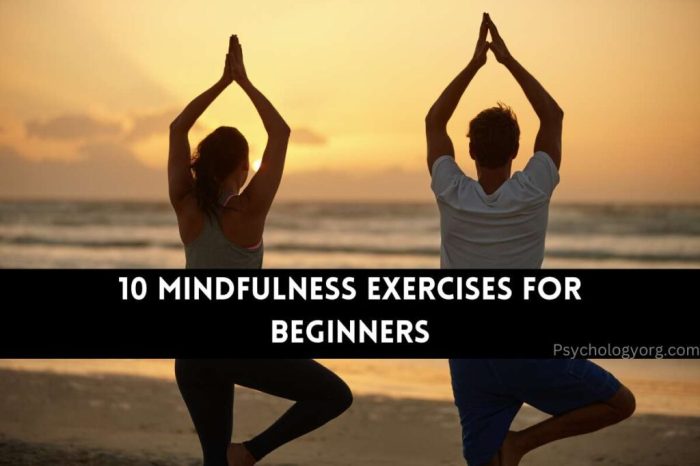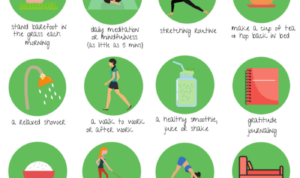Mindfulness Exercises, a powerful tool for improving mental and emotional health, offer a unique way to enhance overall well-being and productivity. Dive into the world of mindfulness exercises and discover their transformative benefits.
Introduction to Mindfulness Exercises

Mindfulness exercises are practices that help individuals focus on the present moment, allowing them to be fully aware of their thoughts, feelings, and sensations without judgment. These exercises are designed to cultivate a sense of calmness, clarity, and awareness in one’s daily life.
Benefits of Practicing Mindfulness Exercises
- Reduces stress and anxiety levels
- Improves concentration and focus
- Enhances emotional regulation and resilience
- Promotes better sleep quality
- Increases self-awareness and self-compassion
- Strengthens overall mental well-being
Importance of Incorporating Mindfulness Exercises into Daily Routines
Integrating mindfulness exercises into daily routines can have a profound impact on mental and emotional well-being. By making these practices a part of your daily life, you can experience increased clarity, reduced stress, and improved overall quality of life.
Types of Mindfulness Exercises
When it comes to mindfulness exercises, there are various types that can help improve mental well-being in different ways. Each type focuses on different aspects of mindfulness and can be effective in various scenarios.
Deep Breathing
- Deep breathing exercises involve taking slow, deep breaths to calm the mind and body.
- This type of exercise can help reduce stress, anxiety, and improve focus and concentration.
- It can be particularly useful in high-pressure situations, before exams, or when feeling overwhelmed.
Body Scan
- Body scan exercises involve focusing on different parts of the body, noticing any tension or discomfort, and releasing it.
- It helps increase body awareness, promote relaxation, and reduce physical tension.
- This exercise can be beneficial before bed to promote better sleep or during breaks at work to release physical stress.
Mindful Walking
- Mindful walking exercises focus on being present and aware while walking, paying attention to each step and the sensations in the body.
- This type of exercise can help improve focus, reduce rumination, and increase overall awareness.
- It can be particularly useful when feeling restless or needing a break from a sedentary routine.
How to Practice Mindfulness Exercises
To start practicing mindfulness exercises, follow these steps for beginners and create an ideal environment for your practice. Stay focused and present with these helpful tips.
Starting Your Practice
- Find a quiet and comfortable space where you won’t be disturbed.
- Sit or lie down in a relaxed position, ensuring your body is well-supported.
- Begin by focusing on your breath, taking slow and deep breaths in and out.
- Notice any thoughts, emotions, or sensations that arise without judgment.
- Gradually shift your attention back to your breath whenever you feel distracted.
Creating the Ideal Environment
- Avoid noisy or chaotic surroundings that may disrupt your focus.
- Dim the lights or light a candle to create a calming atmosphere.
- Use cushions or blankets for added comfort during your practice.
- Consider playing soft instrumental music or nature sounds to enhance relaxation.
Staying Focused and Present
- Set a timer for your practice to avoid constantly checking the clock.
- Gently guide your attention back to your breath whenever your mind wanders.
- Acknowledge any distractions but let them pass without getting caught up in them.
- Practice self-compassion and patience if you find it challenging to stay focused.
Benefits of Mindfulness Exercises

Mindfulness exercises offer a wide range of benefits that impact both the body and the mind. These practices have been shown to have positive effects on physical health, mental well-being, and emotional relationships.
Physical Benefits, Mindfulness Exercises
- Improved immune function
- Reduced inflammation in the body
- Lower blood pressure
- Enhanced sleep quality
Mental Health Benefits
- Reduced stress and anxiety levels
- Improved focus and concentration
- Enhanced self-awareness and emotional regulation
- Decreased symptoms of depression
Emotional Well-being and Relationships
- Increased empathy and compassion towards others
- Improved communication skills
- Enhanced ability to handle conflicts and challenges
- Strengthened emotional resilience
Mindfulness Exercises for Specific Situations
In today’s fast-paced world, stress, poor sleep quality, and lack of creativity can significantly impact our overall well-being. Incorporating mindfulness exercises into our daily routine can help address these specific situations effectively.
Stress Relief
- Take a few minutes to focus on your breathing. Inhale deeply through your nose, hold for a few seconds, and exhale slowly through your mouth. Repeat this process several times to calm your mind and body.
- Practice body scan meditation by paying attention to each part of your body, starting from your toes up to your head. Notice any tension or discomfort and breathe into those areas to release the stress.
- Engage in mindful walking by taking a leisurely stroll outdoors. Pay attention to each step you take, the sensations in your body, and the sounds around you. This can help ground you in the present moment and alleviate stress.
Sleep Quality Improvement
- Try progressive muscle relaxation before bedtime. Start by tensing and then relaxing each muscle group in your body, from your toes to your head. This can help release physical tension and prepare your body for restful sleep.
- Practice a body scan meditation in bed to relax your mind and body. Focus on each body part, releasing any tension or discomfort as you breathe deeply and slowly. This can help calm your thoughts and improve sleep quality.
- Engage in guided imagery by visualizing a peaceful and serene place as you prepare for sleep. Imagine all the details of this place, engaging your senses to create a relaxing and calming environment for restful sleep.
Enhancing Creativity and Productivity
- Start your day with a mindfulness meditation focusing on gratitude and positive affirmations. This can help shift your mindset to a more positive and creative state, enhancing your productivity throughout the day.
- Take short mindfulness breaks during work or creative projects. Close your eyes, focus on your breath, and bring your attention to the present moment. This can help clear your mind, boost creativity, and increase productivity.
- Practice mindful journaling by writing down your thoughts, ideas, and reflections without judgment. This can help stimulate creativity, enhance self-awareness, and unlock new insights for your work or creative endeavors.
Incorporating Mindfulness Exercises into Daily Life
Practicing mindfulness exercises can be highly beneficial, but finding time in a busy schedule to do so can be challenging. Here are some practical tips to help you seamlessly integrate mindfulness into your daily life.
Consistency is Key
- Set a specific time each day for your mindfulness practice, whether it’s in the morning before starting your day or in the evening before bed.
- Start with short sessions and gradually increase the duration as you become more comfortable with the practice.
- Use reminders such as phone alarms, sticky notes, or mindfulness apps to prompt you to take a few moments for mindfulness throughout the day.
- Find a buddy to practice mindfulness with, as having an accountability partner can help you stay consistent.
Creative Reminders
- Associate mindfulness with a specific daily activity, such as brushing your teeth or waiting in line, to trigger your mindfulness practice.
- Use visual cues like placing a small object on your desk or wearing a bracelet to remind you to pause and practice mindfulness.
- Incorporate mindfulness into your commute by focusing on your breath, the sights around you, or listening to calming music.
- Practice mindful eating by savoring each bite, focusing on the flavors and textures of your food.












